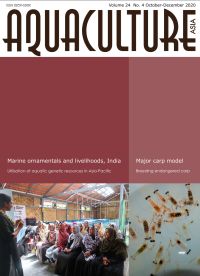Induced breeding of farm-bred and pond-raised critically endangered peninsular carp, Hypselobarbus pulchellus
29 December 2020 | 915 Downloads | .pdf | 1.42 MB | Freshwater finfish, Genetics and Biodiversity, Hatchery and nursery, India
Hypselobarbus pulchellus is endemic to the peninsular rivers of India, mainly the Krishna, Godavari, Tungabhadra, Sita and Tunga. It once formed a major fishery of the Tungabhadra reservoir but has declined to the status of a critically endangered species. H. pulchellus is a bentho-pelagic species which inhabits the deeper part of large streams and rivers along the base of ghats. It is the only indigenous fish that consumes aquatic weeds and submerged grasses, and could play a role in controlling aquatic vegetation in reservoirs, tanks and irrigation canals. Capable of attaining 8 kg, H. pulchellus would make a welcome addition to pond culture practices of India, especially for composite fish culture. This article gives an overview of the breeding and seed production technologies developed by ICAR-CIFA for farm-bred and pond-raised H. pulchelllus.
Creative Commons Attribution.

